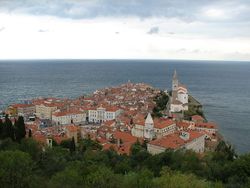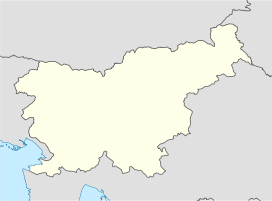Piran
| Piran Pirano |
|||
|---|---|---|---|
| — Town and Municipality — | |||
 |
|||
|
|||
 |
|||
 Piran
|
|||
| Coordinates: | |||
| Country | Slovenia | ||
| Region | Primorska | ||
| Municipality | Piran | ||
| Government | |||
| - Mayor | Tomaž Gantar | ||
| Area | |||
| - Total | 42.2 km2 (16.3 sq mi) | ||
| Population (2002) | |||
| - Total | 16,758 | ||
| - Density | 397.1/km2 (1,028.5/sq mi) | ||
| Time zone | CET (UTC+01) | ||
| - Summer (DST) | CEST (UTC+02) | ||
| Source: Statistical Office of the Republic of Slovenia, census of 2002. | |||
Piran (Italian: Pirano) is a town and municipality in southwestern Slovenia on the Gulf of Piran on the Adriatic Sea. The origin of the name is uncertain, with some scholars favouring derivation from the Celtic "bior-dun" (settlement on the hill), while others prefer the Greek word "pyr" (fire), a reference to the lighthouse on the tip of the peninsula.[1]
The town resembles a large open-air museum, with medieval architecture and a rich cultural heritage. Narrow streets and compact houses give the town its special charm. Piran is the administrative centre of the local area and one of Slovenia's major tourist attractions.
Contents |
Demographics
The municipality has 16,758 (2002) inhabitants and covers an area of 46.6 square kilometres; the town has 4,576 (2002) inhabitants in a single square kilometre. The municipality is bilingual, both Slovene and Italian are official languages.[2] According to the Austrian language census there were 7,379 inhabitants in 1910, 95,97% Italians and 0,09% Slovenes. In 1945.there were 5,035 citizens, 91,32% Italians and 8,54% Slovenes. In 1956. there were 3.574 inhabitants, 67,6% Slovenes and 15,5% Italians. The ethnic composition was due to the migration of Italians to Italy and a Slovene colonization.
Location
Piran is situated at the tip of the Piran peninsula on the Gulf of Piran. It borders Croatia to the south, and the municipalities of Izola and Koper to the east and faces Italy across the Gulf of Trieste and the Adriatic Sea. The highest point, Baretovec pri Padni, is 289 metres high.[3]


Climate
Piran has a Humid subtropical climate with warm summers and cool rainy winters. Snow is rare (usually 3 days per year, almost always in traces). There are 22 days a year with maximum of 30 °C (86 °F) or higher, while one day a year temperature does not exceed 0 °C (32 °F). Fog appears in about 4 days per year, mainly in winter. The climate is also characterized by frequent rainfall.
History and culture
In the pre-Roman era, the hills in the Piran area were inhabited by the Illyrian Histri tribes. These were farmers, hunters and fishermen. They were also pirates who disrupted Roman trade in the north Adriatic Sea[1].
The Piran peninsula was incorporated into the Roman Empire in 178 and 177 B.C. and settled in the following years with rural homes (ville rusticae). The decline of the Empire, from the 5th century AD onwards, and incursions by the Avars and Slavs at the end of the 6th century, prompted the Roman population to withdraw into easily defensible locations such as islands or peninsulas. This started local urbanisation and by the 7th century, under Byzantine rule, Piran had become heavily fortified. Despite the defences, the Franks conquered Istria in 788 and Slavs settled in the region. By 952, Piran had become a part of the Holy Roman Empire[1]. The earliest reliable records of the area are in the 7th century work Cosmographia by an anonymous cleric of Ravenna. Here, the name "Piranon" (Piran) was referred to as a Roman town on the Istrian coast[1].
Piran is the birthplace of composer and violinist Giuseppe Tartini, who played an important role in shaping its cultural heritage. The town's main square, Tartini Square (Slovene: Tartinijev trg, Italian: Piazza Tartini), is named after him.
In 1892, to mark the 200th anniversary of Tartini's birth, the people of Piran decided to erect a monument in his honour. Venetian artist Antonio dal Zotto was commissioned to create the larger-than-life bronze statue of the maestro, which was eventually mounted on its pedestal in 1896. The statue dominates the square, overlooked by the Cathedral of Saint George.
The municipality's festival is on October 15, which celebrates the foundation of the first naval detachment Koper in 1944. The municipality has an international airport[4] and a marina[5].
Piran is now the seat of the Euro-Mediterranean University (EMUNI), founded in 2008 as one of the cultural projects of the Barcelona Process: Union for the Mediterranean.
International relations
Twin towns — Sister cities
Piran participates in town twinning arrangements to encourage international contacts and understanding.
|
Gallery
 Tartini square with the cathedral of St. George |
 Tartini square at night |
 view of the town from town medieval wall |
 View towards the town port |
References
- Notes
- ↑ 1.0 1.1 1.2 1.3 "Portoroz and Piran". Turistično združenje Portorož. 2004. http://www.portoroz.si/en/default.asp?id=546http://www.portoroz.si/en/default.asp?id=546. Retrieved 2008-08-24.
- ↑ Statistical Office of the Republic of Slovenia
- ↑ Piran Municipality site
- ↑ Portorož Airport site
- ↑ Marina Portorož site
- ↑ "Łańcut Official Website - Foreign contacts".
 (in English) © 2008 Urząd Miejski w Łańcucie, Plac Sobieskiego 18, 37-100 Łańcut. http://www.lancut.pl/asp/en_start.asp?typ=14&menu=76&strona=1. Retrieved 2008-11-20.
(in English) © 2008 Urząd Miejski w Łańcucie, Plac Sobieskiego 18, 37-100 Łańcut. http://www.lancut.pl/asp/en_start.asp?typ=14&menu=76&strona=1. Retrieved 2008-11-20.
External links
- Municipality of Piran
- Information Portal of Piran
- Multimedia Center of Piran
- Piran on Geopedia
- Piran travel guide from Wikitravel
- EMUNI (Euro-Mediterranean University)
- Piran Photogallery
|
|||||||||||
|
||||||||

